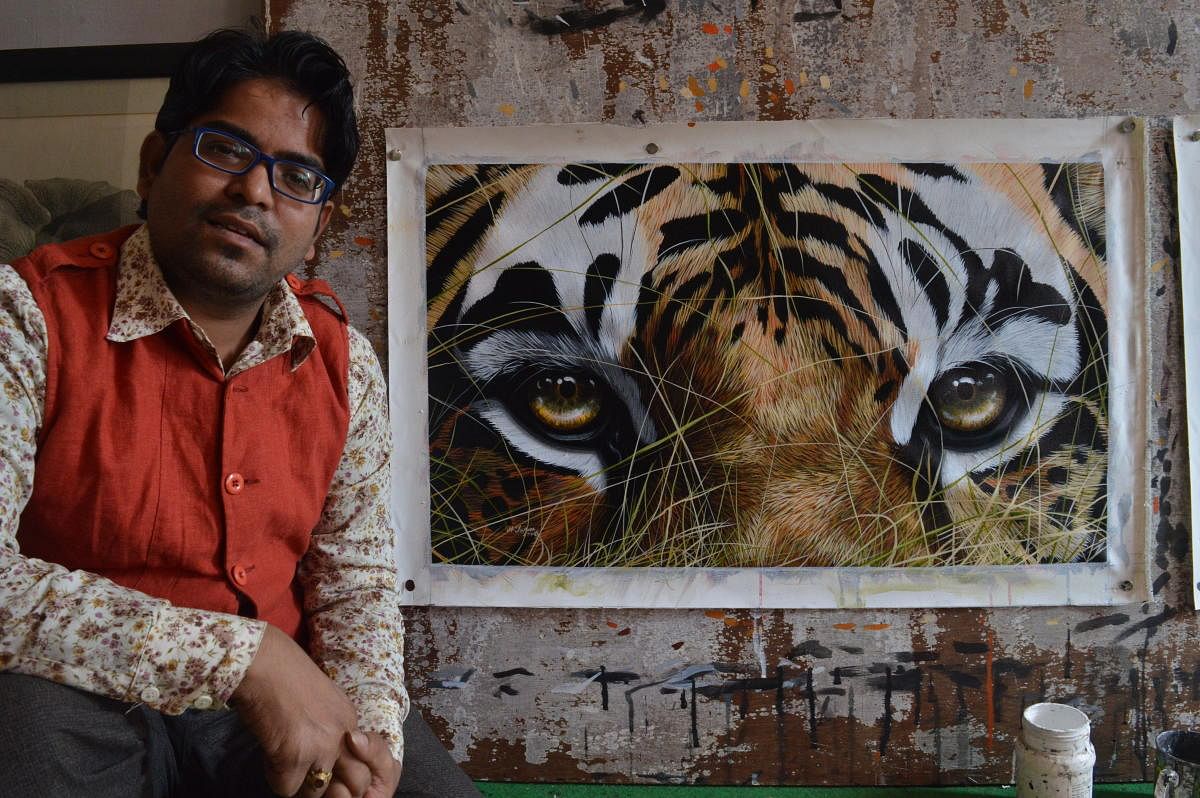
If I were not a painter, I would probably not have thought about climate change as much as I do now.” “My art is helping in re-building environment by offering livelihood, and the ultimate validation comes when a tourist buys a painting,” he sighed with a subtle smile. A lone light flickered above as we stood in the small dusty room listening to the man with a mission.
A little over 35 years, he sports a pair of thick glasses and a sacred yellow-red thread around his right wrist. He stood in front of a huge canvas for a split second before running his hand along the edge of the frame. Pointy green leaves enveloped the surface. A giant feline peered through the leaves. The eyes — cold but beautiful, the stripes — royal, the forehead sparkled with a gentle glow of white. The life-like painting of Bandhavgarh’s tiger had us mesmerised as Mahesh Jangam watched us from behind the desk.
We were at the Bandhavgarh School of Art. The art school, that began in 2009, is the brainchild of Mahesh Jangam. It is at the heart of the National Park where there are a number of guest houses and forest lodges for tourists to stay.
Brush with art
Bandhavgarh is one of the famous National parks in India known for its high tiger density and a large bio-diversity. It is located in the central state of Madhya Pradesh and is surrounded by the beautiful outlying hills of the Vindhyas.
Born in Ranthambore, Mahesh took a keen interest in painting from a very young age. During his teens, he chanced upon a group of artists from the Ranthambore School of Art. The school’s tiger paintings were already a rage among tourists and for a kid like Mahesh, it was a dream come true.
Soon, Mahesh began to frequent the school. Initially, his paintings were handed over to customers for free, as a souvenir. After a decade, he was finally recognised as an artist, whose name began to appear on brochures. His paintings finally had a price. “I was doing well. My paintings were selling and I was making enough money. But, I wanted more,” he recalled.
Around that time, he got a call from his friend in Bandhavgarh to visit. Mahesh visited the place, and decided to set up the Bandhavgarh School of Art just like the art school he had graduated from. “I had saved some money and I felt it was time to nurture new artists and take my art to those places where it had not reached,” he remembered.
True to his alma-mater, Mahesh teaches for free, providing drawing material like paper, paint, brush — everything. “Teaching this art is not about money. I learnt for free too,” he said.
Scenic beauties
But, it was tough in the beginning at Bandhavgarh. His paintings were not selling much and he soon realised he had to do something more. “A lot of people helped me and I began to stock souvenirs. But, painting continued to be my priority. There is a side-room, where I continue to teach to this day,” he said as he showed us around his shop.
Small canvasses adorned the walls, papers with colourful drawings were stacked up neatly in a corner. Most of the paintings were scenes from the jungle — monkeys, birds, wild flowers.
The school mostly attracts kids from the forest and nearby villages. Most of them, learning to hold the brush and learning the strokes for the first time. Although some children do not see painting as a profession, they all begin to enjoy the process at some point. And, almost all of them are thrilled to learn many new things about wildlife and nature.
There are two other walls in the school with many large canvasses full of extravagant stripes in golden yellow and in grey black that are breathtakingly real.
“Tyger! Tyger! burning bright, In the forests of the night, What immortal hand or eye, Could frame thy fearful symmetry?” I had to ask. But, I am not William Blake so, I turned to the man with the brush in brown cotton kurta, “Why Tiger?” I asked him, still unable to hide the pulsating excitement in my heart.
The man looked up thoughtfully, “This is what I learnt to paint initially,” he paused, “There is something about tigers that draws everyone to it. They are regal, most loved but also endangered,” he said.
One of Mahesh Jangam’s most famous painting is Blue Eyes. Blue Eyes, Mahesh told us, was a male tiger with blue eyes in Bandhavgarh who died due to territory fighting. Mahesh and the artist fraternity decided to immortalise the big cat. And, so began the Blue Eyes series of paintings which soon became a rage among tourists.
Mahesh Jangam’s ‘Blue-Eyed Tiger’ painting today adorns the President’s house in New Delhi. ‘Blue Eyes’, has also graced some of London’s prestigious art galleries.